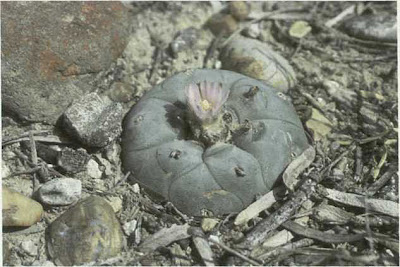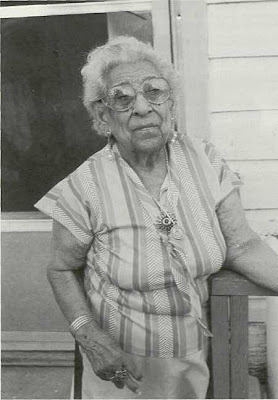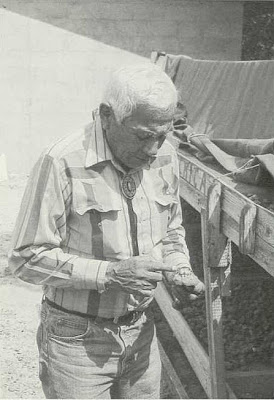In last month’s post on the troubled Texan peyoteros I referred to Anderson’s article on the peyote situation in Texas. Given the importance of this work, I saw it fit to bring it here in its full length - unfortunately I only have an old scan of the article, so the photos are a bit muddled but here goes...
 The "Peyote Gardens" of South Texas: a conservation crisis?
The "Peyote Gardens" of South Texas: a conservation crisis?Cactus & Succulent Journal 67(2): 67-73 (1995)
Edward F. Anderson
Desert Botanical Garden,
1201 N. Galvin Parkway,
Phoenix, AZ 85008
More than a quarter of a million Native Americans use the peyote cactus (Lophophora williamsii) (Fig. 1) as a sacrament in a Pan-Native American religion called the Native American Church. This bona fide religion includes Native Americans from throughout the United States and Canada. Almost all of the peyote consumed in their ceremonies comes from the "peyote gardens" on the Mustang Plains in south Texas, which has been carefully documented by Morgan (1976, 1983) and by Morgan and Stewart (1984). Federal and Texas laws permit the collecting and use of peyote by Native Americans in their religious ceremonies.

Fig. 1 - Peyote (Lophophora williamsii) in habitat on Las Islas Ranch, Starr County, Texas.
The origins of the Native American Church are complex, and the reader can refer to detailed accounts of how the modern peyote religion arose in the late nineteenth century through the influences of traditional Native American ceremonies and Christianity in both Mexico and the United States (Anderson, 1980; Stewart, 1989). This paper describes the long relationship of Hispanic "peyoteros" in south Texas and members of the Native American Church, as well as the impact of many years of collecting peyote tops or "buttons" within the Tamaulipan Thorn Shrub vegetation. Many report that the peyote populations are greatly diminished in size (Morgan and Stewart, 1984; Jerry Patchen, pers. comm.; Salvador Johnson, pers. comm.; Jackie Poole, pers. comm.). Is the continued collecting of the plant for religious purposes leading to a serious conservation problem? Will peyote continue to be available to Native Americans in the foreseeable future?
I recently had the opportunity to return to south Texas, where I had collected and studied peyote populations more than 30 years ago. I met Hispanic peyoteros, visited their drying sites, and talked with leaders of the Native American Church. I also examined a peyote site, where plants had reportedly been harvested about five years earlier.
Peyote has a broad distribution throughout most of northern Mexico and across the Rio Grande into Texas (Anderson, 1980). Though peyote occurs in west Texas near Big Bend National Park, the most extensive area within the U.S. is from the mouth of the Pecos River southward and eastward nearly to Brownsville. The main area in which peyote has been harvested commercially is within Starr, Jim Hogg, Webb, and Zapata counties, primarily along the western Bordas Escarpment, the Aguilares Plain, and the Breaks of the Rio Grande (Morgan and Stewart, 1984). Over 90% of this land is privately owned and well-fenced.

Fig. 2 - Amada Cardenas, an Hispanic peyotero, who has collected peyote for Native Americans since 1933.
Hispanic peyoteros and some Native Americans have harvested peyote within this region for more than 100 years. Until the 1960's the main area for collecting the plant was in the more northern part, mostly in Webb County in the vicinity of Mirando City. In fact, the first peyoteros worked out of a small community just to the south of Mirando City called Los Ojuelos. Abandoned many years ago, the small town is now being rebuilt. Hispanic peyoteros and Native Americans developed a strong relationship, which has persisted to the present. The home of Amada Cardenas (Fig. 2), who is the oldest living peyotero, is located at the edge of Mirando City. It has become an important religious site for Native Americans who visit the area, with peyote meetings held in either a hogan or tipi. Amada, now 90 years old, was born in Los Ojuelos and became a peyotero in 1933. She is known to most Native Americans as "Mom"; often she provides Road Chiefs (church leaders) with especially fine specimens of peyote (Fig. 3) to serve as "Father Peyote" in the ceremonies they lead. Peyote growing in her garden is also highly revered (Fig. 4). She and the other peyoteros in the northern part of peyote country primarily sell dried peyote. More recently, peyoteros have operated in the more southern area around Rio Grande City; they deal mainly in fresh or "green" peyote, but dry some as well.

Fig. 3 - Especially large, fine peyote tops, which will be used as "Father Peyotes" in religious ceremonies of the Native American Church.

Fig. 4 - Peyote growing in the garden of Amada Cardenas. Note the coins and corn-husk cigarette butts that have been left as "offerings."
Peyoteros must be licensed by the Texas Department of Public Safety and the Drug Enforcement Administration (DEA) of the federal government, paying annual fees of $5 and $400, respectively (Salvador Johnson pers. comm.; Jerry Patchen, pers. comm.). They must keep accurate records of how many pieces of peyote they harvest and sell each year. Responsible peyoteros lease the rights to collect peyote from the land owners, a typical lease costing $800-1000 for permission to work on a small ranch for 30 days (Salvador Johnson, pers. comm.). Leases for ranches of several thousand acres would cost far more. Unfortunately, a few peyoteros fail to secure permission to collect on private land, thus causing land owners to become angry because of their trespassing. Illegal trespassing was a particularly bad problem in the 1960's and 1970's when non-Native American "hippies" or members of the drug cult came to south Texas to search for peyote. They would often camp illegally and have extended drug parties on private property. Their illegal trespassing, coupled with their association with more serious drugs, caused many ranchers to close their lands to everyone, including peyoteros and members of the Native American Church. These "hippies" have not returned in recent years.

Fig. 5 - Salvador Johnson, who has been a peyotero for more than 30 years, with drying peyote "buttons."
There are currently 11 peyoteros working in south Texas. Each harvests and sells about 200,000 tops a year (Salvador Johnson, pers. comm.). However, productivity varies from individual to individual, as well as the season of the year. For example, no one collects during Texas's hunting season, for it is far too dangerous to wander through the brush harvesting plants, with hunters searching through the thick brush for the numerous white-tailed deer. One peyotero, Salvador Johnson of Mirando City (Fig. 5), has been in the business for more than 30 years. He works throughout the northern region of the cactus's distribution in south Texas, an area of 200,000 to 300,000 acres, and collects more than 300,000 buttons or tops a year. He claims that he and four other workers can collect about 30,000 heads on 25 acres of land in about 5 hours — if the plants are abundant. It takes 10 days to dry the buttons (Fig. 6), for which he charges 15-17 cents a piece. The size of the buttons makes no difference with regard to price, for both state and federal laws are concerned only in the number of pieces collected and sold. Thus, Salvador is able to charge $ 150-170 per 1000 dried buttons, plus $5.00 per 1000 for shipping. The price for dried peyote has steadily risen. In 1966 the cost was $15 per 1000 buttons, but it had risen to $80 per 1000 by 1981 (Morgan and Stewart, 1984). Thus, the price has doubled in the last 10 years.

Fig. 6 - Freshly harvested peyote tops that are being dried for sale to Native Americans.
Anthony Davis, also known as White Thunder (Fig. 7), is an 83-year-old Pawnee Road Chief and President of The Native American Church of the United States in Texas. Anthony, a longtime member of the Church, says (pers. comm.) that the annual demand by all branches of the Native American Church in the U.S. and Canada for peyote "buttons" is 5-10 million. Unfortunately, the peyoteros of south Texas come far short of reaching this need. If they were to harvest that many tops, what would be the longterm effects on the natural populations? In fact, what is the impact of their present collecting of about two million tops each year?

Fig. 7 - Anthony Davis, a Pawnee Road Chief, examining drying peyote "buttons."
I visited a population of peyote on Las Islas Ranch in northern Starr County. The ranch is presently closed to outsiders, including peyoteros, with numerous high fences and locked gates. The area we visited had never been root-plowed and consisted of natural vegetation (Fig. 8), with heavy stands of mesquite and other native shrubs. No peyoteros have been on the property in more than three years. I examined numerous plants and found about half had been previously harvested. The usual technique for harvesting is to use a flat, short-handled shovel or machete, which is carefully pushed just beneath the soil to sever the top of the plant from the tuberous root system. If the top is removed at ground level, regeneration is rapid, usually with one - or more - heads arising from the original root system (Figs. 9, 10). New tops will sprout in less than two months if the plant is in a state of active growth. The Las Islas site had many peyote plants with one or more small heads, most less than 5 centimeters (2 inches) in diameter. Several large individuals were found growing under large mesquite trees. Peyote seems to be remarkably resilient if proper harvesting techniques are practiced by peyoteros.

Fig. 8 - Natural habitat of peyote on Las Islas Ranch, Starr County, Texas.

Fig. 9 - Cluster of small peyote tops.

Fig. 10 - Soil removed to show that the tops arise from a large root system from which a top had been removed several years earlier.
What is the future of peyote harvesting in south Texas? The long-term prognosis, if present conditions continue to exist, is grim. Interestingly, the most serious threat to peyote is not its harvest by peyoteros. They are actually good conservationists and have a responsible approach to their livelihood. They want to carefully nurture the wild populations so that they will have a steady income. Members of the Native American Church, in turn, are dependent upon the peyoteros, for there is no other legal supply of their sacrament. Some will travel to south Texas to collect their own plants, but most cannot afford the time or expense.
The two most serious threats to a continued supply of peyote are root-plowing (Fig. 11) and the locking up of ranches to the peyoteros. These two activities by the land owners are understandable, because they want to make their land economically productive, as well as to protect themselves from lawsuits. The brushland has many snakes and other dangers, and in this time of litigation many owners fear the possibility of lawsuits if anyone is injured or killed on their property. Hunting has become a significant source of income for many ranchers, with groups of hunters paying for permission to be on the land during the winter hunting season. The property has therefore been closed in order to propagate game, prevent poaching, and insure that only those who have paid are on the property. Elaborate, high fences have been built to restrict the movement of deer.

Fig. 11 - Root-plow (note man standing beside it), with Opuntia engelmannii in the foreground and the newly cleared area behind.
In recent years ever-larger numbers of Native Americans are coming to visit the "peyote gardens," which are almost totally on private land that is fenced and posted. Some Native Americans resent being prohibited from visiting sites where their most important "medicine" grows, thus creating serious tensions between them and the ranchers.
Root-plowing is the only means whereby a land owner can prepare land for cattle grazing, after which various grasses are planted. Of course, native plants are virtually all destroyed, with the
exception of Opuntia engelmannii (Fig. 11). It multiplies rapidly by vegetative means once the ground is disturbed and in many places it forms nearly impenetrable thickets.
As more and more land is subjected to rootplows or is locked up, there is an ever-increasing pressure on those remaining populations of peyote that are legally accessible. An area of peyote should not be recut for at least five years, but often peyoteros cannot wait that long if the demand for buttons is great. Thus, smaller and smaller tops are harvested (Fig. 12) at ever-higher prices.

Fig. 12 - Very small peyote "buttons," indicating that peyoteros are being forced to harvest regenerated tops before they have grown to a sufficient size. Photos by author.
There appear to be three ways to alleviate the probable shortage of peyote within the near future. None is easy, and none may be possible.
First, efforts should be made to persuade ranch owners to allow peyoteros to legally have the right to harvest peyote on their property through leases or permits. Landowners of Texas feel strongly that their lands are private. Negotiations would be difficult, but if some ranchers would allow carefully supervised harvesting, then perhaps others would follow. Unfortunately, the image of peyote as a drug rather than a sacred medicine is hard to dispel. This is an unfortunate consequence of the drug culture and their coming to Texas to collect and consume peyote.
Second, negotiations could be initiated with the Mexican and U.S. governments to allow the importation of dried peyote from Mexico where the supply is still plentiful. This would provide income for Mexican harvesters, with U.S. Hispanics serving as importers and distributors. However, at present Mexico has laws which are even more restrictive regarding possession and use of peyote than in the U.S. Perhaps the new NAFTA treaty and the greater interest of both governments to work cooperatively may at least provide the possibility of discussions about peyote.
Third, salvage operations could be undertaken with the cooperation of ranchers who are rootplowing fields. If they could be pursuaded to allow peyoteros to collect entire peyote plants prior to their destruction by the plow, then those collected could be placed into cultivation. Suitable fields with security would have to be found, but such an activity would provide income to the rancher, to the harvester, and to the grower. The plant grows well in cultivation, though few peyoteros and Native Americans have been inclined to propagate other than small back yard gardens of peyote, thinking that the wild populations will never be depleted. Unfortunately, this is not the case.
Peyote is not a dangerous drug that victimizes Native Americans as alcohol has done. Rather, it is a sacred plant having a history of use of more than 6000 years. It is only used ceremonially and as medicine. It is not addicting, nor does it cause harmful effects. It is one of the most important medicines to Native Americans. Their religion, in which peyote is used as the sacrament, is highly moral and serious. For anyone who has experienced the night-long ceremony of singing, praying, and mediating, there can be only respect and admiration. Serious efforts must be made to assure the continued supply of peyote for members of the Native American Church.
Acknowledgments
Financial support for this investigation was provided by the CSSA Research Fund. It is much appreciated. In addition, I wish to thank Dr. Stacy Schaefer of The University of Texas-Pan American for arranging travel, accommodations, and interviews in south Texas. I also want to thank Jerry Patchen for several valuable suggestions in the writing of this paper.
References
Anderson, E. F. 1980. Peyote: the divine cactus. University of Arizona Press, Tucson.
Morgan, G. R. 1976. Man, plant, and religion: peyote trade on the mustang plains of Texas. Ph.D. dissertation, University of Colorado.
Morgan, G. R. 1983. The biogeography of peyote in south Texas. Bot. Mus. Leafl., Harvard Univ. 29:73-86.
Morgan, G. R., and O. C. Stewart. 1984. Peyote trade in south Texas. Southwest. Hist. Quart. 87:269-296.
Stewart, O. C. 1989. The peyote religion: a history. University of Oklahoma Press, Norman.


















